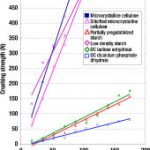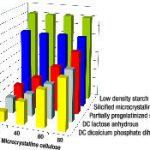Excipients are the mortar in the majority of solid dosage pharmaceutical applications, added to active ingredients to facilitate their effective functioning. They can be used to aid in binding ingredients together, disintegrate active compounds, dilute ingredients and facilitate tablet compression. They also have a variety of cosmetic uses, such as adding colour, flavour, preservatives and coating films.
Yeli Zhang and Sibu Chakrabarti
In the direct compression tabletting process, active ingredients are clearly the crucial element in any formula, but the physical properties of many actives present a challenge to manufacturers. Some may lose potency by reacting to air and moisture, while others may not be easily compressible, which has an impact on tablet size.
Avoiding such potential problems in the direct compression process is where manufacturers turn to excipients, using them to bind the ingredients together and impart the desired levels of strength and compressibility. By their very nature, binding excipients are often highly compressible and can transfer this property to other ingredients.
The choice and selection of binder is critical. It must fulfil certain requirements, especially in terms of powder compressibility, density, moisture content and flow properties. Consequently, there are currently relatively few materials that meet the criteria and qualify for classification as directly compressible excipients. In the following, the basic properties of six widely available binders are examined and compared:
- Microcrystalline cellulose (Avicel PH 101, FMC Corporation)
- Silicified microcrystalline cellulose (SMCC 50, Penwest Pharmaceutical)
- Partially pregelatinised starch(Uni-Pure DW, National Starch & Chemical)
- Low density starch(Uni-Pure LD, National Starch)
- DC lactose anhydrous (DC Lactose, Quest International Group)
- DC dicalcium phosphate dihydrate (DI-TAB, Rhodia)
Analysing the physical properties of binders
The bulk, tap and true densities of the powders are listed in the table. DC di- calcium phosphate dihydrate has the high-est bulk and tap densities, followed by partially pregelatinised starch, DC lactose anhyd-rous, microcrystalline cellulose, silicified microcrystalline cellulose and finally low density starch. Compared to the bulk and tap densities, the true densities of the excipients are all fairly close to one another, except DC dicalcium phosphate dihydrate.
All excipients were within the expected moisture content specifications, with the partially pregelatinised starch and low density starch exhibiting the highest moist-ure content, followed by microcrystalline cellulose, silicified microcrystalline cellulose, DC dicalcium phosphate dihydrate and DC lactose anhydrous.
Good flow properties are a critical factor for excipients to the successful development of any pharmaceutical tablet. Flowability is typically determined by powder properties such as density, surface area, moisture content, particle shape, particle size and size distribution. The Mean Time to Avalanche, or MTA, is the measure of the powder flowability, while the scatter value defines the regularity of the flow behaviour. A powder with good flow properties will have an MTA close to zero and a low scatter value.
DC dicalcium phosphate dihydrate dem-onstrated the best flow properties, combining the smallest MTA with a low scatter value. The poor flowability of microcrys-talline cellulose is attributed to the particle shape (rod-like particles), small particle size and low bulk density, a theory supported by the fact that silicified microcrys-talline cellulose exhibited improved flow properties. The moderate flow properties of partially pregelatinised starch may be attributed to its higher density (improves flowability) and higher moisture content (reduces flowability). The very poor flowability of low density starch comes from its extremely low bulk density and large surface area.
Compact properties
Overall, a gradual improvement in crushing strength was observed as the compression force increased (Fig. 2). At the same compression force, microcrystalline cellulose, silicified microcrystalline cellulose and low density starch produced the hardest compacts, whereas DC dicalcium phosphate dihydrate produced the softest tablets. The hardness of partially pre- gelatinised starch and DC lactose anhydrous fell in-between the two.
The hardness of a compact depends on two factors: the binding capacity and the compact porosity. Compact porosity is related to compression force. Binding capacity is generally due to material properties. For example, the extremely strong binding properties of microcrystalline cellulose and silicified microcrystalline cellulose are mainly caused by hydrogen bonds between the plastically deformed, adjacent cellulose particles. These hydrogen bonds on an extremely large surface area are brought into close contact during plastic deformation. In addition, the moisture that exists within the porous structure of microcrystalline cellulose and silicified microcrystalline cellulose acts as an internal lubricant and facilitates slippage and flow within the individual microcrystals during plastic deformation, enforcing the for-mation of hydrogen bond bridges.
Partially pregelatinised starch showed low hardness. The low strength of starch is because plastic deformation is too slow to produce adequate interparticulate binding during rapid compression. In the meantime, due to elastic recovery during decompression and ejection, brittle fracture occurs, which reduces compact strength. The very good binding functionality of low density starch may be attributable to its rapid plastic deformation during compression instead of fragmentation.
DC lactose anhydrous is a spray-dried anhydrous lactose, which has both amorphous and crystalline regions. Under compression, the crystalline regions undergo brittle fracture readily at lower stresses, while the amorphous regions undergo plastic deformation and contribute to its binding capacity.
DC dicalcium phosphate dihydrate exhibited poor binding properties. The brittle nature of DC dicalcium phosphate dihydrate leads to considerable fragmentation during compression. Fractures create a large number of interparticulate contact points, which implies a comparatively weak type of bonding. The compact strength is therefore low compared to other binders.
Hardness of biphasic mixtures
Microcrystalline cellulose was mixed with each of the other excipients in turn and tested for hardness. The microcrystalline cellulose/low density starch mixture demonstrated the highest crushing strength, which was actually higher than that of its separate components. The crushing strength of microcrystalline cellulose/silicified microcrystalline cellulose mixture was lower than that of microcrystalline cellulose, but higher than that of silicified microcrystalline cellulose (Fig. 3).
For all the other biphasic compacts, the crushing strength was lower than that of microcrystalline cellulose and gradually decreased as the proportion of microcrys-talline cellulose in the mixture was reduced.
Conclusions
It is not simply a matter of obtaining the excipient, adding it to the process and reaping the product benefits, however. Every excipient has different properties and in processing will exhibit characteristics unique to those properties and to the specific application in which it is being used. It is therefore essential that pharmaceutical manufacturers select the most effective excipient for each and every one of their products.
cpp 457
Share:









